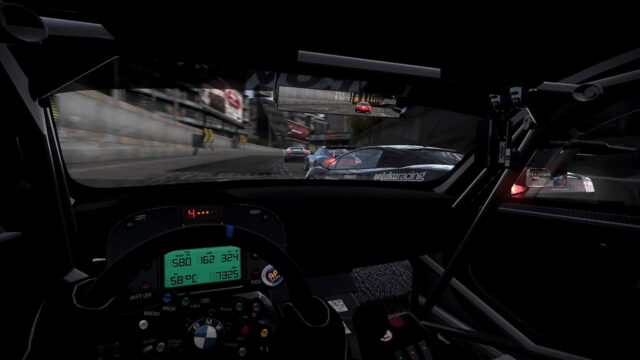
Need for Speed: SHIFT
Written by: Rik
Date posted: January 23, 2021
- Genre: Racing
- Developed by: Slightly Mad Studios
- Published by: Electronic Arts
- Year released: 2009
- Our score: 7
Need for Speed was always a brand: the name given to EA’s arcade racing series, released on an annual basis throughout the 90s and 00s. But by 2008, such a relentless schedule had started to take its toll, and the resulting dip in commercial and critical performance forced consideration of a new strategy: farm the series out to different developers, allowing each team more time to work on the games while preserving the ability to release a new NFS each year. And so, for a few years at least, Need for Speed was no longer a series that even retained an identity as determined by a single development team, and instead literally became a name to put on the box.
The first of three games from different teams (we’ve covered the second and third already) was in many ways the most curious: SHIFT was to be a more serious racer, aiming at a position alongside the console big boys like Forza and Gran Turismo, and distancing itself from the series’ recent history as a daft arcade knockabout supported by silly storylines and camp video cut-scenes. In all likelihood, SHIFT was intended as a launching-off point for a spin-off series, allowing arcade and sim to co-exist in parallel, as with Forza/Forza Horizon and Dirt/Dirt Rally in the modern era. Indeed, there was a SHIFT 2, the pre-release press for which contained some truly confounding PR babble about branding and identity, before another re-think on the direction of the series.
A move into the world of more po-faced track-based racing was also a move away from my comfort zone, but despite some reservations, my ongoing commitment to Need for Speed coverage meant I was compelled to give it a go, with the fact that developers Slightly Mad Studies had some shared DNA with Simbin, responsible for the touring car sim RACE, acting as some comfort. And, to be fair, SHIFT takes a very gentle, pat-you-on-the-head-for-driving-in-a-straight-line approach to proceedings, and the game’s career mode opens with a mystery unnamed man taking you around a simple training lap to determine how much assistance you might need in the game itself.
(This man’s role is undefined, but he appears to be cast in a similar but more low-key role as the grumpy crew chief from TOCA Race Driver, in that he has some kind of vested interest in your success while also talking you through the various stages of progress during the career mode. I kept wanting to call him Alan, and he’s got exactly the kind of voice that a man interested in motorsport would have, kind of like Tiff Needell mixed with a little of Jim Rosenthal. He occasionally tries to call you ‘mate’ and it always sounds unnatural.)
Anyway, the training lap allows you to review the settings that have been pre-selected for you based on your performance, and as that lap was most likely your first ever go at the game, it’s entirely possible that you’ll have cocked it up to some greater or lesser extent, and so you may wish to take the opportunity to have another go. However, it’s still hard to gauge things at this stage, and some settings can still be tweaked later on, should they not be to your liking.
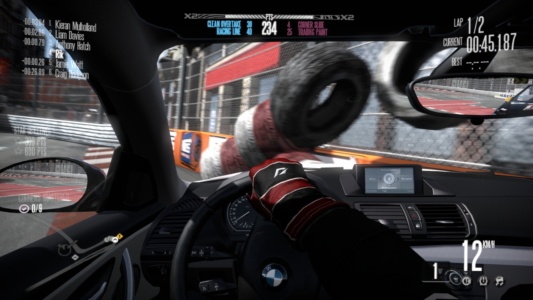
Whoops! More serious collisions than this are accompanied by visual effects emphasising the impact and resulting disorientation of the driver. Which some people might find annoying, but I quite liked.
With setup complete, in the time-honoured tradition, a career mode of roughly a million races stretches ahead of you. Alan tells you that the goal is to work your way up to the NFS World Tour, the ultimate prize in the game, which is unlocked via progression through four other tiers of competition. At the outset, the sheer number of events that you are seemingly required to grind through is rather overwhelming, and this is compounded by an ongoing bombardment of stats and numbers implying that you’re some kind of racing genius, despite being at the very start of your career.
One recurring theme is some spiel about your racing ‘style’, which supposedly measures whether you favour ‘precision’ or ‘aggression’ based on what you do in races. It’s unclear to what extent this is actually a choice, and it could be argued that you pretty much have to play the game in a particular way to succeed. For example, it’s hard to avoid aggression when you’re mainly dealing with races that are 2-3 laps in length and you’re usually plonked into the middle of the grid at random. As with the aforementioned RACE Driver, there’s not much room for finesse when you have a limited amount of time to barge your way to the front of the pack.
Indeed, much of the driving feels like a battle, and the cockpit view (returning to NFS for the first time since Porsche 2000) not only conveys the fact that motor racing is disconcerting, stressful and loud, but there’s also the sense that you’re dragging the car around the track in a most unsophisticated way. While you may indeed earn points for being a ‘precision’ driver, it certainly doesn’t feel that way after the bruising impact of heaving yourself around a couple of laps, which makes the resulting accolades congratulating you on becoming a ‘corner master’ (or similar) feel rather hollow. Other than having the racing line guide switched on and following it as best you can, what happens, happens.
Eventually, you come to realise that progress through the career is not contingent on taking any of this in, or indeed on completing each and every single event in front of you. As it turns out, the game is quite generous in terms of what you need to do to unlock subsequent tiers, and you can afford to bypass, or underperform on, less-favoured events. Which is a relief, as some work better than others. Standard race and time trials are solid, but the drift events are more of a mixed bag and seem curiously out of place, almost as if they were only included to maintain a link of sorts with the previous games in the series.
Worst of all of them is Driver Duel, a one-on-one lap race, often unlocked at the end of a series or tier, and half-heartedly pitched as a boss battle against a named driver. In an attempt to generate some drama, Alan tells you that whoever it is (or their manager) has been touch wanting a race, but as it’s the first you’ve heard of them, it means very little. Duels are a best-of-three event, with each of you starting ahead on the grid before a rolling start finale, and their difficulty level seems massively at odds with the rest of the game. The only way to succeed seems to be to get ahead and stay ahead early, and then block your opponent for all it’s worth for the duration, because if they take the lead, they soon disappear off into the distance, never to be seen again.
Despite initial appearances to the contrary, the career is pleasingly free of faff. Choosing and upgrading your car is largely without risk, with the surfeit of races allowing you plenty of wiggle room financially, and unlike in ProStreet you aren’t punished for your choices, as you can sell a car and recoup your costs if it doesn’t work out. There are tuning options, if such things interest you, but it’s an area that I prefer to steer clear of, and to be honest there’s little reason to dwell on vehicle selection: you’re free to pick the one with the most favourable-looking bar charts, whack on a few upgrades and racing livery, and get on with it. Meanwhile, bonus, so-called ‘invitational’ events allow you to race with a variety of other vehicles on a one-off basis.
The racing, it has to be said, is pretty satisfying stuff. There’s an excellent sense of speed and danger, and despite the slightly muscular handling, any sense that you might be being let off the worst consequences of mistakes by whatever assistance you might be receiving is balanced by the fact that major errors are usually fatal to your chances. And, although any individual rivalry with named opponents fails as a concept, the other drivers do seem as if they are racing against you, and are allowed to make the same kind of misjudgements, occasionally found skidding off at corners, instead of just drifting around the course with drone-like precision.
Indeed, getting to the NFS World Tour provided some thrilling moments: the fastest cars really do intimidate with their power, and the first time you make the step up, it seems impossibly fast and unlikely that you’ll make it round in one piece. With practice, of course, they can be mastered, but when you factor in the extra high stakes of the final rounds with the longer races, the higher speeds and more twitchy handling become a background risk.
To take an example, your correspondent somehow managed to blow a 9-second lead on the last corner of the last lap of a race due to a minor misjudgement, a series of events that would usually elicit some unedifying dummy-throwing and foul language. However, in this instance, it didn’t seem cheap, and the AI wasn’t lurking immediately behind me to pounce: I had just made an honest mistake, and was punished. Such moments make success, when it comes, all the more satisfying, and the final 90 minutes or so of my time with SHIFT were really good — some of the best fake racing, in fact, that I’ve experienced in recent memory.
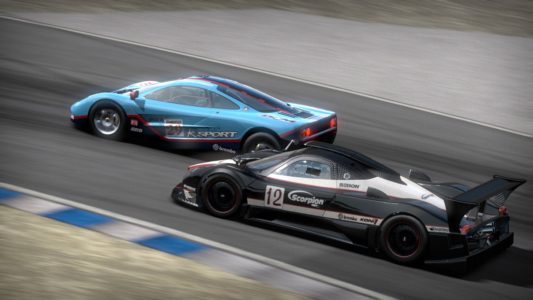
At the top tier, you have the usual suspects among the supercars: Pagani, Koenigsegg, Bugatti, Mclaren F1, etc.
Pulling off ultimate victory, though, had to be its own reward. Having diligently completed as many early races as possible, at Tier 4 I finally figured that I could do without some of the more tedious remaining events and proceed straight to the World Tour. At the end of which, Alan, my chum and companion, offered merely qualified congratulations, along the lines of “Well done, mate, this is everything we’ve been working towards! *pause* But still keep racing to improve your driver profile!” Having performed the grind for most of the career, evidently it was still not enough for Alan. But once you’ve beaten the best, why would you go back? Lewis Hamilton doesn’t pop off to have a go on the old go-karts in the off-season.
It also shouldn’t take so long to get there. There are so many events, it goes beyond simply providing choice or a way around the ones you don’t like. All racing career modes can be lengthy and repetitive at times, and at least here the structure is fairly transparent from the outset. But there’s rather too much that feels unnecessary, like you’re not learning or experiencing anything new, and are instead just going through the motions. A better arcade racer would have a more thoughtfully constructed career mode. As a sim, there seems to be too much here to put the hardcore driver off: the lack of qualifying, the short races, the patronising achievements.
That leads to another question: how exactly this fits into the NFS series. Short answer: it doesn’t. Whatever else you might say about Need for Speed, it’s not about track racing. You may quibble about the cynical ‘street’ aspect of 00s NFS, but there was still a core of roads, traffic, and police chases that maintained some links to the original. This looks like what it is: EA hired some people with decent sim pedigree to make them a game.
If this hadn’t had the series branding, I might not have given it a go, and while it was a bit more sim-my and serious than I might have liked, it’s certainly a polished and playable racer. And, to be fair, it makes a much better job of doing whatever ProStreet was trying to do than that botched mess of a game. Ultimately, SHIFT failed to win over either the arcade or sim crowd to maintain the spin-off series that EA so desired. But as a hybrid, in the mould of the TOCA Race Driver series (without the daft story), it’s a solid effort.

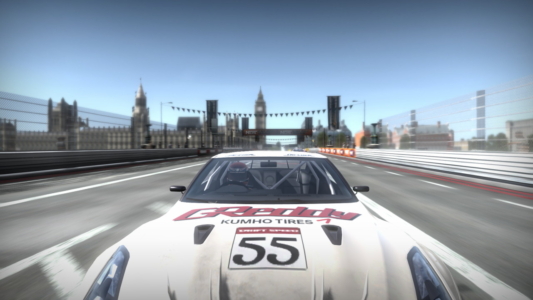
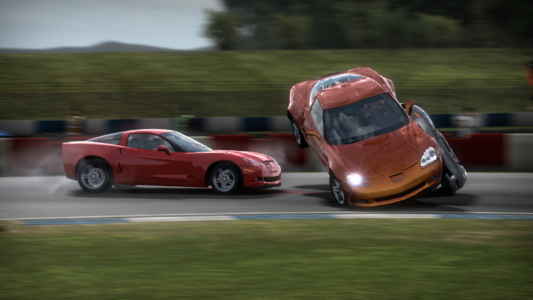
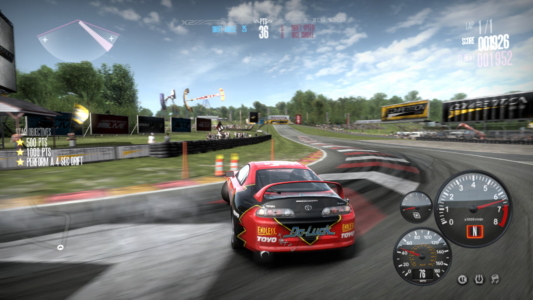
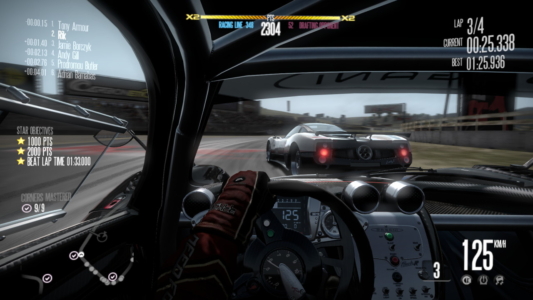

 Posts
Posts